The family and I finally got to take a jaunt to Benezette, Pennsylvania -- the central eye of Pennsylvania's wild elk herds.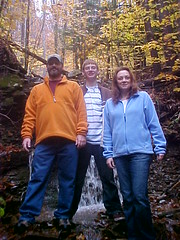
When most people think of Elk, they don't think of Pennsylvania. The north central part of our state however does have a healthy elk population though. I'm thinking we have close to 1,000 animals thriving in the northern counties, and spreading. It's a very unique experience, watching wild elk feed in the neighborhood lawns and gardens.
Here we have a pair of bulls that were feeding along the road. One had a collar, to help biologists study and learn about the elk.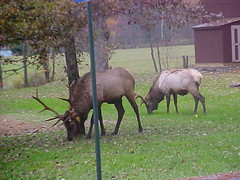
One of the bulls struck a pose for my sony mavica: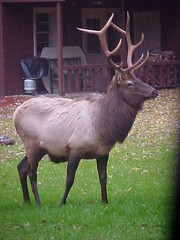
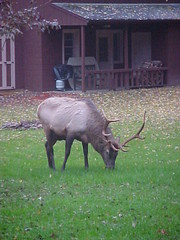
North American elk are divided into six subspecies of the red deer (Cervus elaphus) family. It would probably be better to call these ecotypes, rather than subspecies, because their differences are due largely to what and how much they eat.
Before settlers and cash hunting, there was a subspecies of elk (again, red deer if you're European) that lived in Pennsylvania, up into Ontario, Quebec, and much of the eastern United States. Due to a lack of hunting regulations, the species is NOW thought to be extinct. The subspecies we now hold are introduced Rocky Mountain Elk. These are very similar in habits, and feeding to the extinct eastern elk, and thus, have been introduced to many places worldwide. Some bulls of this subspecies can reach almost 2,000 lbs, and be 5 and a half feet tall at the shoulder.
Unlike their smaller relatives the White-tailed Deer and Mule Deer, Elk are very large animals, and do not number in the millions globally. Their range is spread out, and herds are sparse to keep from overfeeding. They do cause a lot of damage, but fact is, Elk were here first and we should do everything in our power to preserve them in their natural habitat!
Breeding
All summer long, male Elk (bulls) live in what are cold "Bachelor Groups". They co-exist with each other peacefully, with large velvetty antlers. But toward the end of summer, the velvet is shed, and a chemical change causes the bulls to depart from one another, or even clash with the onset of the RUT, which starts sometime in September and lasts about 6 weeks.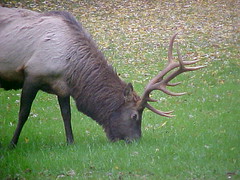
I'm sure we've all seen it on television; the visual of a massive bull elk bugling into the crisp autumn air. Let me say that I've witnessed this foray in person, and watched a massive bull (7 points on one antler, 8 on the other) bugle only 30 yards away. I watched him pace around the trunk of an apple tree, and rake the tree branches to knock down more once the crop on the ground was devoured. The loud wailing scream of a bugle was enough to induce goosebumps, and within moments there was a snaking line of cars waiting to watch the elk in his glory.
Click here to hear the various sounds of the Elk.
During the breeding season, Elk, like many deer, engage in mock fights with brush, saplings, and small trees, raking them with their antlers and often causing much damage to whatever unfortnate plant was available. This activity serves a few purposes:
- it strengthens neck muscles for the breeding season
- acts as practice, and undoubtedly a stress relief
- marks territory, and serves as a scent post for other elk
The young, sick, and old bulls do very little breeding. Groups of cows are rounded up by the areas healthiest bulls; this is called a harem. Most of the breeding are done by bulls who are in the prime of their life -- which is between 5 and 12 years of age. Though typically a Rocky Mountain Elk harem is between 12 and 60 cows/yearlings/calves, in Pennsylvania the harems are much smaller. A bull will not give up his harem without a fight, even if it means aggressively rounding up a wandering female who has no interest! He constantly battles to keep his cows in a group, and he may occassional resort to sharp antler prodding, or even GORING if a cow refuses to cooperate. Cases of goring are rare however.
With that harsh reality in mind, let me let you in on a little secret. Most cases of a cow wandering are moot, because any cow who had will enough to leave the harem would, and COULD do so with only slight effort. Elk are not slow animals, and very often dissaproving females flee the harem. The love-sick bull will only chase so far before returning to his harem.
Locomotion
Although heavy, the Elk is actually a very swift animal. It's style of running typically puts it somewhere in the 30 mph range, but for short bursts an elk may reach 45 miles per hour. Now hear this...a 160 pound white-tailed deer makes MORE noise when bounding through the forest than a 1,600 lb elk! Elk are very sure footed, and literally seem to glide across the ground when they run.
As far as beautiful autumn scenery, and monstrous Pennsylvania mountains...it's best to leave that to the photographs taken that day:
(Old Graveyard from the 1800's. I thought Jude might like this one.)
(Large stream that cuts through Benezette and St. Marys.)
(Strange evergreens that are NOT ever-green. They turn yellow each fall.)
(Fall foliage, and main tourist elk viewing area.)
(One of a few informative panels for the tourists to read while viewing the elk.)
(Mom...on the VERY wobbly bridge. I nearly got sick crossing it.)
(This waterfall is tucked in the Pennsylvanian wilderness. We stopped along the tiny dirty road that twists through the forest for some pictures.)
(Brother, up on a boulder.)
Enjoy the photos. I had a BLAST taking them. I can't wait to go back.

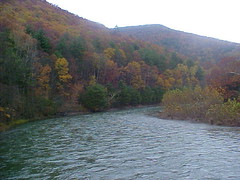
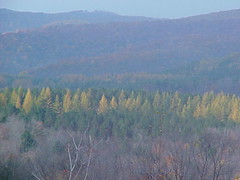
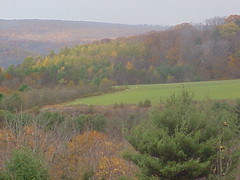
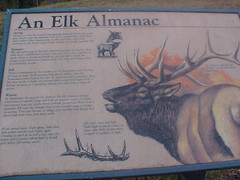
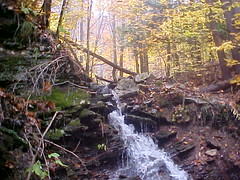
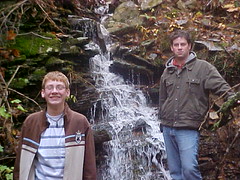
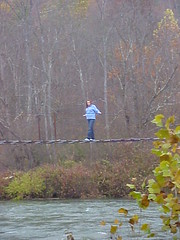
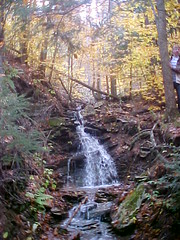
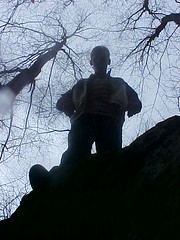




|